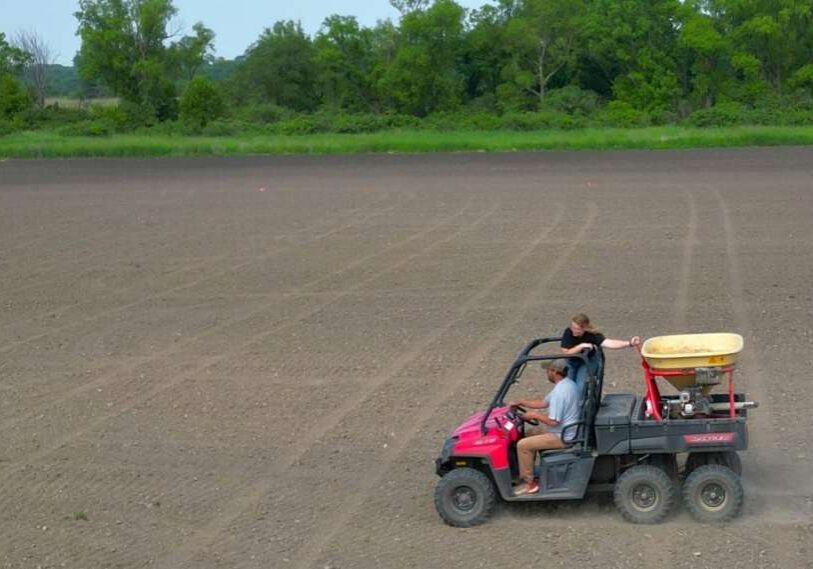‘Sweet Business’ in the Hardwood Forest

DUSCHEE CREEK VALLEY, FILLMORE COUNTY — Vast hardwood forests are one of the many natural assets we enjoy in bluff country. Canopies of maple, oak, birch, hackberry, aspen, walnut, basswood and more provide great habitat for wildlife and great opportunities for carbon sequestration, hunting, bird watching, hiking, logging — and for a few weeks each spring, the forest can provide one of nature’s sweetest treats: maple syrup.
But maple syrup itself is not naturally flowing. It’s the result of hard work and commitment — a commitment that in 2025 began for the Carlin family on one recent record-breaking warm March day. Like years past, the Carlins began the many steps needed in their annual production of Carlin’s Sugar Shack Pure Maple Syrup.

Dave Carlin, Marlene Carlin and John Carlin (left to right) stand by their evaporator on a sap boiling day. (Photo by Alison Leathers)
A 40-year journey
Dave Carlin and his friend Eric began making maple syrup in high school in the mid-1980s in Austin, Minn. As Dave explained, “We just wanted to try something fun.”
To learn how to make maple syrup, Dave and Eric read books and magazines and visited a maple syrup producer south of Austin, “to see how that operation worked,” stated Dave.
They stopped making maple syrup after high school. Then in 2003, Dave started maple syruping again with his dad, John Carlin, after Dave and his family moved to rural Lanesboro.
Dave, his wife Marlene, and John, first began by tapping trees on a hillside across the street from their property. They hauled sap in five-gallon buckets and boiled the sap over a flat pan on a wood fire. Eventually they purchased a three-wheeler that could transport 35 gallons of sap and since then, their operation has grown.

The network of tubing in a nearby woodland that collects sap from each tree and brings it to the pumphouse. (Photo by Alison Leathers)
Neighbors helping neighbors
The Carlin’s property does not contain enough trees to tap, so they had to look elsewhere to find their sap. Thanks to a hunting app that took overhead photos of the area during peak fall colors, Dave identified a nearby stand of black maple trees on land owned by David Bakke and got permission from his rural neighbors to tap those trees.
A pump house is located in this stand of trees where the sap can be pumped and collected. It used to run on a gas-powered motor, but thanks to Jerry McCabe, the farmer across the road, Dave has electricity to power the pump house. He worked with Carrolton Township to run a power line under the road that can be taken out when the maple syrup season is over.
Dave is connected to maple syrup producers all over the United States and Canada as he and his wife often attend the annual North American Maple Syrup Council conferences. He serves on the board of the Minnesota Maple Syrup Association and is certified in maple syrup grading.
Both Dave and Marlene have learned so much from other producers who, as Dave shared, “tap anywhere from five to 4,000 trees” and from attending meetings.
The production of Carlin’s maple syrup is truly a cooperative effort between neighbors with a lot of collaborative learning among producers.

Dave Carlin checks the flow of the sap coming from a black maple. Look closely at the tubing to see the sap flowing from left to right. (Photo by Alison Leathers)
A trip to the forest
Tapping trees for syrup usually begins the first week of March, but it all depends on temperatures needing to be around 40 degrees Fahrenheit during the day and around 20 degrees at night.
Once that temperature range is seen in the forecast, Dave drills trees while they are still frozen and inserts a tap about a week before those temperatures begin. If he can hug a tree and not have his hands meet together, he will put in two taps. Trees smaller than that only get one.
Carlins’ current system includes about 400 taps that all have tubing running to the pump house using a vacuum pump that collects the sap into a stainless-steel tub. The tub holds some 500 gallons and has an auxiliary tank that holds about 650 gallons for overflow.

The pumphouse and auxiliary tank where the sap is pumped to and collected. (Photo by Alison Leathers)
The system utilizes smart technology with a cellular signal so Dave can use an app on his phone to control settings and turn the pump on and off based on conditions. This is very helpful as Dave and Marlene still work elsewhere full-time and they can check on and control things remotely.
Once the tanks in and around the pumphouse are full, Dave or John drive their four-wheeler with a tank on the back to haul sap back to their property for processing.

The reverse osmosis machine sap is run through to remove water before boiling. (Photo by Alison Leathers)
From sap to syrup
Back at the Carlin property, the sap is put into stainless steel tanks, either a refrigerated tank or non-refrigerated tank. It is important to refrigerate the sap if you do not cook it immediately, especially on a warm day. “If it’s not boiling, it’s spoiling,” Dave said.
Maple sap is generally 40-to-1, water-to-sugar, depending on the tree. A sugarmaker’s job is to extract the water. The first step in that process is to check the raw sap for sugar content, and they are happy if the content is around 2.5-3 degrees Brix.

Syrup is poured into the measuring tube to determine the sugar content on a Brix scale. (Photo by Alison Leathers)
The Brix scale measures the concentration of dissolved solids (in this case, sugar) in a liquid. The lower the number in Brix, the more evaporation is needed to get to finished syrup.
To quickly increase the Brix in the sap and avoid prolonged boiling, the Carlins put the sap through a reverse osmosis process. Compared to boiling, reverse osmosis is a faster way to remove water from the sap. The extracted water is saved in large storage tanks while the sap is put in another storage tank and ready to be cooked.

Steam boils off the sap, turning it into syrup. (Photo by Alison Leathers)
Once the reverse osmosis has brought the sap to around 12 Brix, it is put in tanks outside the evaporating shed. From these tanks, the sap is plumbed right into the evaporator, or large cooker, that boils the sap. The sap slowly trickles through two different compartments and their many channels as it boils.
Wood is burned, mainly using scrap pieces from Root River Hardwoods, to heat the evaporator. What’s boiled off exhausts through a hood above the evaporator. During this process, the Carlins continue checking the sugar content to get it to the desired 67 Brix, or about 67 percent sugar.

Dave Carlin and Marlene Carlin are checking the evaporator as the sap boils. The stacked wood will fuel the evaporator’s fire. (Photo by Alison Leathers)
It takes 800-1000 gallons of sap to start the cooking process, so the Carlins can freeze some of their syrup that is close to 67 brix and put it back in the evaporator to start cooking a new batch — Dave calls it “sweetening the pan.” The reverse osmosis water is kept for washing out the filters, the evaporator and the other equipment.
The Carlins are very busy some four to six weeks for maple syrup production each year — a process that requires, among other things, taste-testing the syrup regularly at room temperature to make sure it doesn’t have any off flavors, especially towards the end of the season as “the sap can get a funky taste when the trees begin to bud,” Marlene explained.

Marlene Carlin is taking syrup out of the evaporator to test for its sugar content. (Photo by Alison Leathers)
The final product
After the syrup is cooked and brought to the desired sweetness, the next step is to filter the syrup to remove the sugar sand (also called niter). This is a natural element that occurs in pure maple syrup as the minerals are concentrated through the boiling process.
Once filtered, the syrup is bottled in bulk kegs or individually bottled for retail. Some of their syrup is aged for eight months in bourbon barrels from a local distillery (and then the distillery gets those barrels back for a third use). They also make syrup with added vanilla and cinnamon flavors.
The Carlins have a Minnesota cottage food license and have produced up to 225 gallons of syrup in a single season; in 2024 they produced 120 gallons. They also make maple-covered almonds, pecans and cashews; maple cotton candy; and hard candy, with more product ideas in the works.

Carlin’s Sugar Shack maple syrup and maple sugar are seen here at Paddle On Coffee and Maker Emporium in Lanesboro, MN. (Photo by Alison Leathers)
The future is sweet
Dave and Marlene don’t yet have plans to slow down or reduce production. In fact, over the next few years they would like to add a new building that houses all of their production elements and a commercial kitchen to create more products.
The Carlins will release a new brand name soon and have plans to tap 80 more maple trees by getting the lines ready this summer.
On top of syrup-making, they also maintain about 30 bee hives to create their Carlin’s Colonies honey.
Why does the Carlin family venture to make maple syrup and other products each year? “It’s a natural product that people like,” Dave explained, “and most know how much work it is to produce.”
It is definitely a labor of love to commit to the process of sap-to-syrup, and it’s a blessing that Southeast Minnesota has the trees — and the Carlins — working hard to produce their Carlin’s Sugar Shack maple syrup. It surely makes life a little sweeter.
Look for Carlin’s Sugar Shack maple syrup at the Lanesboro Farmers’ Market (May-October), Paddle On Coffee and Maker Emporium in Lanesboro, Farm Charm in Harmony, and Blossom Hill Orchard in Preston. Beyond maple syruping as a business, explore these Root River Current stories about maple syruping as a hobby:






